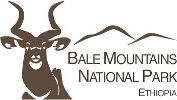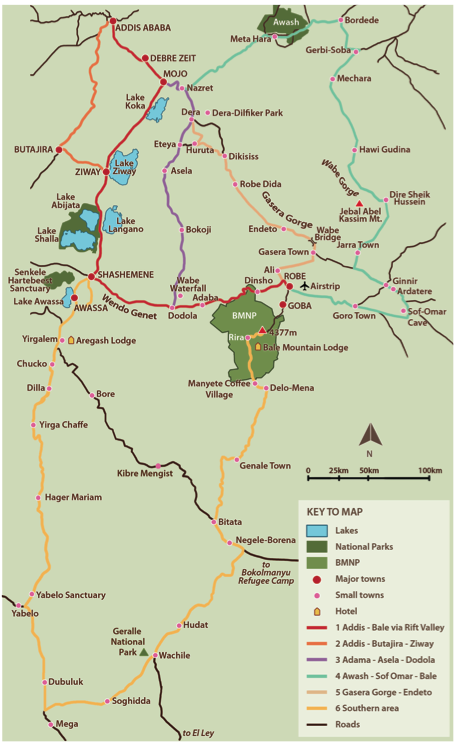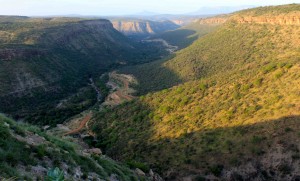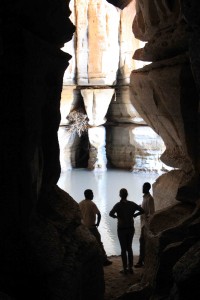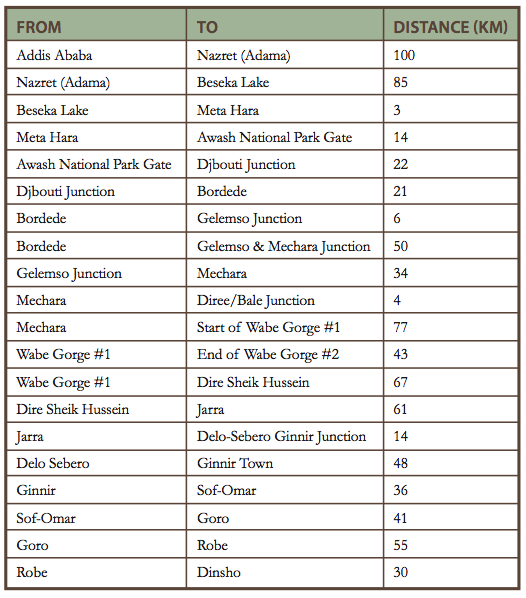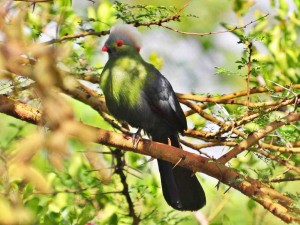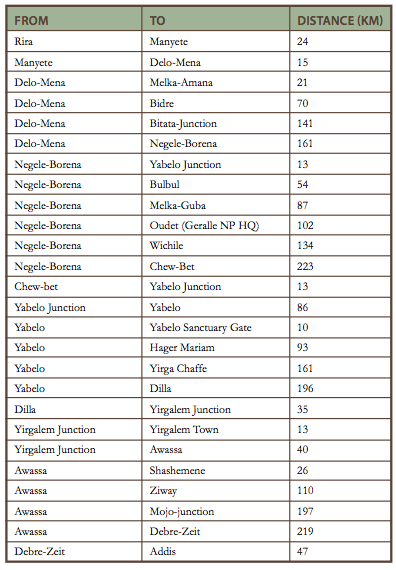These routes include sites of cultural, historical and natural interest both en-route and nearby the Bale Mountains National Park. All care has been taken to document accurate driving directions, although keep in mind that roads and road conditions may change.
Suggested Itinerary #1: From Addis with stops
This route takes you through a diverse national park, an undiscovered gorge, an ancient Muslim shrine and a mysterious underground cave en route to the Bale Mountains.
Addis Ababa to Awash National Park (1 night): The drive from Addis Ababa to Awash National Park is 215km. About halfway, you will pass through Adama (Nazret) – an ideal stop for a coffee or tea, and the most famous city for meat in Ethiopia. Driving on towards Meta Hara, you will cross Lake Beseka on a road that seems to hover just above the water. Look for great white pelicans, marabou storks and yellow-billed storks on its shores. Once in Awash National Park, take a short walk through the bushland inhabited by baboons to the Awash River Falls. Continue to the Crocodile Beach and the edge of the spectacular Awash Gorge. The park is known for its diversified bird species including Arabian bustards, secretary birds, rosy-patched shrikes and Abyssinian rollers. Other interesting species include northern carmine bee-eater, chestnut-bellied sandgrouse and chestnut-headed sparrow-lark. Next, drive across the Ilala Sala Plain in search of the easily spotted beisa oryx, greater kudu, Salt’s dik-dik, bat-eared jackal and various gazelles. There is a lodge in the park as well as designated camping grounds. See the directory in the back of this book for more information.
Spend the next day exploring the nearby Filwoha hot springs at the northern part of the national park, an oasis encircled by palm trees. Troops of Hamadryas baboon pass nearby. The tall grass plains of Filwoha conceal pygmy falcons, harlequin quails, yellow- breasted barbets and rosy-patched shrikes. The hot springs area features such birds as the Abyssinian scimitarbill, rufus-necked wryneck, black-throated barbet and the gold- mantled woodpecker. This section of the park offers the colorful topography of the Fentale volcano.
The undiscovered gorges of Wabe Shebele (1 night):
Leave Awash and drive 25km to Bordede. Turn right onto a gravel road (in good condition) leading to Mechara. This road will take you through the Agemetu Valley to the scattered villages across the Hararghe plateau, encircled by chat farms and dotted with circular Harar Oromo huts. After 50km you will arrive in Gelemso. Before reaching town, turn right at the junction which will take you to Mechara – the gateway to the undiscovered Wabe Shebele Gorge. Stop in Mechara for lunch where the restaurants are well known for their meat. Then drive onwards through the vast lowlands speckled with termite mounds and typical lowland huts made with red soil. After 67km you will reach the Wabe Gorge, consisting of three smaller gorges; this is arguably the most dramatic gorge in the country. The road takes you from the 1,000m high edge down to the river, through narrow, winding roads. See here for more detailed information. There are good camping grounds around the first and second gorge; it is also possible to camp at the Culture and Tourism Office in nearby Dire Sheik Hussein. To get there, continue on the same road through the gorge 25km past the end of the second gorge. There are no hotels in Dire Sheik Hussein.
Following the pilgrim’s footsteps from the shrine to the holy cave (1 night):
The ancient holy shrine of Dire Sheik Hussein, named after the holy muslim Sheik Hussein Bin Malka, stands at the edge of town. Here, one can tour the impressive conical, white “gamo.” See here for more detailed information. From here, a good dirt road offers stunning views of the Gubayeu Mountain on the way to the small town of Jarra. From Jarra, continue 14km towards Delo-Sebro, where the road splits in two. Take a left turn towards Ginnir (an ideal lunch stop) through vast agricultural fields coated with Euphorbia plants. Then, take a right turn to the center of town (near the Gofa Hotel and Ginnir Hospital), and continue driving through the beautiful Ardatere Valley.
At the bridge, turn right and follow the road for 36km until you reach the entrance of Sof- Omar. Keep an eye out on your left for “Sof-Omar” painted in red on a rock, just before the road takes a harsh right turn. The cathedral-like Sof-Omar Caves are the longest network of underground caves in Africa. See here for more detailed information.
Bale (3 nights): From Sof-Omar, drive 126km on the road that leads from the caves, to Dinsho, passing through small villages towards the breathtaking Dadimous Mountain.
Suggested Itinerary #2: From the Bale Mountains further south
From the Bale Mountains, head south to Delo-Mena where the earth is red and camels are abundant to Negele-Borena, a lively lowland town. Continue on to the isolated Geralle National Park and the untouched southwestern part of Ethiopia reaching the Yabelo Wildlife Sanctuary en route to the home of Prince Ruspoli’s turaco, as you continue to the south or return to Addis.
From Bale to Prince Ruspoli’s turaco country (1-3 nights):
Leave Dinsho for the Sanetti plateau – see here for Sanetti plateau and Harenna forest driving directions. Leaving behind the moist tropical forest, drive 50km south to Delo-Mena. Delo-Mena is known for its coffee and offers basic accommodation. The next morning, drive through grasslands and the Genale Valley to Negele-Borena, a large, bustling town. Take a right turn at the junction of Haymi Refu village and drive through scrubland to the Geralle National Park; you may encounter dik-diks running along the road on the way. The park headquarters is located in a small village called Oudet. The park was established in 2006 and is about 4,000km2. After obtaining your entrance permit, continue on the same road for three to four hours to the entrance. Continue through bush and grassland to Direre Wilderness Campsite, located close to the Dawa River and encircled by large riverbank trees. After a brief rest in the campsite, set off in search of wildlife including kudu, oryx and gerenuk. Keep an eye out for elephants, often seen drinking from the Dawa River.
There are several options for your next destination.
Option 1: Continue further on the same road to Arero via Wichale Village, considered the best place to see the Prince Ruspoli’s turaco – first discovered in 1892 and not seen again until the 1940s. There is a rough road that takes you to Yabelo where you can spend the night; it is advisable to check the road conditions beforehand.
Option 2: Drive towards Yabelo and en route explore the village of El Sod. Known as the “House of Salt,” El Sod is famous for its deep crater lake, out of which muddy, black salt has been extracted for centuries. Continue to Yabelo, home of the Streseman’s bush crow and the white-tailed swallow. The Streseman’s bush crow is found in groups of up to 30 birds and is considered to be quite enigmatic. The acacia bush areas around Yabelo feature many birds which are near endemic to northern Kenya and southern Ethiopia. Yabelo is the largest town between Dilla and the Kenya border town Moyale. It is one of the country’s premier birding sites due to high diversity and endemism that combine to offer a superb birding experience.
The 272km asphalt road from Yabelo to the Southern Nations Nationalities and Peoples Region capital Awassa takes you through the acacia scrub of the southern Rift Valley and fertile highlands. The road then takes you towards Yirga Chaffe, where some of the best coffee in the world originates. From there, continue to Dilla, where traditional stelae have been erected in Ethiopia. The site of Tutu Fella features around 80 of these carved stones. The drive then continues on to Yirgalem, the gateway to the newly established Loka Abaya National Park and the Aregash Lodge, one of the best lodges in the country built using local materials in the style of a traditional Sidama village. See the directory for more information. The Loka Abaya National park is located on the northeastern side of Lake Abaya about 50km southwest of Awassa. It covers an estimated area of 500km2. At present the main attractions of the park are the views of Lake Abaya and the riverine forests. The park is also reputed to have a population of African wild dogs. Here, you can camp at a temporary campsite at the park headquarters.
From Yirgalem it is only 40km to Awassa on good asphalt road. Fresh pineapples and colorful sidama basketry – made of papyrus grass - can be found along the roadside. One of Ethiopia’s most attractive cities, Awassa is known for its scenic lake. Continue further north among the central Rift Valley lakes to Addis passing through Shashemene, best known for its Rastafarian population. Past Shashemene is Lake Langano, Ethiopia’s most developed lake destination with a number of quality lodges and lakeside resorts. Drive further through the small and bustling town of Ziway, known for a lake of the same name with five little volcanic islands. Many white pelicans and yellow-billed storks dwell on its shores. From Langano you can continue on to Mojo where you make a left turn towards Addis; a four hour drive.
